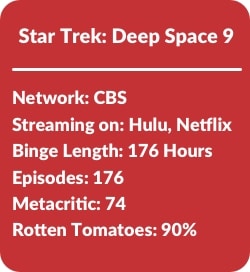This article is part of our One Perfect Binge bracket project. Follow along with here for updates, and on Twitter, keep tabs via #OnePerfectBinge.
 Star Trek: Deep Space Nine was a series ahead of its time. Instead of retreading the then-familiar format of a top of the line spaceship exploring the stars, it offers another angle on the utopian galaxy that Star Trek creator Gene Roddenberry had envisioned. Created by Rick Berman and Michael Piller, the third series in the television franchise abandons the nomadic format of the previous incarnations, focusing instead on a space station located near the war-torn and recently liberated Bajor.
Star Trek: Deep Space Nine was a series ahead of its time. Instead of retreading the then-familiar format of a top of the line spaceship exploring the stars, it offers another angle on the utopian galaxy that Star Trek creator Gene Roddenberry had envisioned. Created by Rick Berman and Michael Piller, the third series in the television franchise abandons the nomadic format of the previous incarnations, focusing instead on a space station located near the war-torn and recently liberated Bajor.
That’s not to say they entirely abandoned the Star Trek creed to find “new life and new civilizations, boldly going where no man had gone before.” In the pilot episode of Deep Space Nine, a wormhole to the other side of the galaxy is discovered, turning the titular station from a dreary dead-end assignment to a bustling hub of trade and exploration.
Deep Space Nine is officially the longest series on the One Perfect Binge Bracket. It ran for a full seven seasons, making a total of 176 episodes. This kind of serialization caused the show to suffer at the time (when most people watched television live) but is optimized for a voracious binge. It gives watchers a lot to dig their teeth into, with rich story arcs and complex, well-developed characters.
Take Benjamin Sisko, the commanding officer: As cliche as it may be to argue over who is the best Star Trek captain, each commanding officer sets the underlying tone for their series. Kirk is a raucous cowboy. Picard is a philosopher. Janeway is a survivor. Deep Space Nine is headed by Commander Sisko (Avery Brooks). Not only was he the first person of color to serve as a commanding officer on Star Trek, but he was also a widower and a single father who begins his journey disenfranchised with Starfleet and considering resigning his commission.
Brooks’ multifaceted performance as Sisko is raw and intense. He shifts expertly from a gentle, sensitive father cooking homemade jambalaya to a stern war leader willing to conspire with spies. He blackmails barkeeps, plays baseball on the holodeck, and punches Q right in the face. Throughout the run of the show, he is put through the wringer as he becomes an unwilling religious icon for the Bajoran people and finds himself commanding the front line of an intergalactic war.
He is joined by a diverse ensemble crew including old soul Jadzia Dax (Terry Farrell), former Bajoran freedom-fighter Major Kira (Nana Visitor), shapeshifting Chief of Security Odo (René Auberjonois), wet behind the ears Doctor Bashir (Alexander Siddig), and Star Trek: The Next Generation veterans Chief O’Brien (Colm Meaney) and Worf (Michael Dorn). Beyond the bridge crew, the station becomes home to a rich blend of civilian, military, religious, and political figures. More than just a crew, it’s a multicultural community that you’ll want to immerse yourself in and never leave. The show takes advantage of its huge cast and equally huge airtime, giving each character a rich backstory and room for growth.
The stationary setting ties together the Star Trek universe in an unprecedented way, preferring complex and series-long narrative arcs over the monster-of-the-week format that The Original Series, The Next Generation, and Voyager favored. Going beyond two-parter episodes, it features multi-episode arcs like the six-part run that opens the sixth season. This long-form storytelling is more reminiscent of modern television shows than its contemporaries, and the show is better for it.
Deep Space Nine follows one primary conflict throughout the series: the Dominion War saga. This conflict puts the station at a strategic position on the front lines of an all-out war, digging into ugly issues like shifting borders and alliances, the line between freedom fighters and terrorism, living with PTSD, and the dangers of over-reaching security. Many of these themes are more relevant to a modern audience than they were when the series first aired in the mid-1990s.
Deep Space Nine also takes the time to develop species and concepts introduced in earlier series, establishing a deeper geopolitical context for all of the Star Trek that has come since. This blend of moral ambiguity and mysticism paved the way for darker and more complex science fiction to come, like the 2004 Battlestar Galactica remake as well as current incarnations of the Star Trek franchise.
Throughout their compromises and sacrifices, the crew members of Deep Space Nine find themselves in situations where they have lost not only their peace and freedom but also their moral conviction. Through that darkness, light always shines through. Despite deconstructing Roddenberry’s utopia, Deep Space Nine does not do so out of malice, and it never abandons his dream of a better future. Sisko and crew start out as reluctant strangers who learn to trust and support each other as they fight for their lives, and for the survival of their ideals. By the end of this binge, you aren’t going to want to leave Deep Space Nine any more than they would.
0 comments:
Post a Comment